

Grammar


Tenses


Present

Present Simple

Present Continuous

Present Perfect

Present Perfect Continuous


Past

Past Continuous

Past Perfect

Past Perfect Continuous

Past Simple


Future

Future Simple

Future Continuous

Future Perfect

Future Perfect Continuous

Passive and Active


Parts Of Speech


Nouns

Countable and uncountable nouns

Verbal nouns

Singular and Plural nouns

Proper nouns

Nouns gender

Nouns definition

Concrete nouns

Abstract nouns

Common nouns

Collective nouns

Definition Of Nouns


Verbs

Stative and dynamic verbs

Finite and nonfinite verbs

To be verbs

Transitive and intransitive verbs

Auxiliary verbs

Modal verbs

Regular and irregular verbs

Action verbs


Adverbs

Relative adverbs

Interrogative adverbs

Adverbs of time

Adverbs of place

Adverbs of reason

Adverbs of quantity

Adverbs of manner

Adverbs of frequency

Adverbs of affirmation


Adjectives

Quantitative adjective

Proper adjective

Possessive adjective

Numeral adjective

Interrogative adjective

Distributive adjective

Descriptive adjective

Demonstrative adjective


Pronouns

Subject pronoun

Relative pronoun

Reflexive pronoun

Reciprocal pronoun

Possessive pronoun

Personal pronoun

Interrogative pronoun

Indefinite pronoun

Emphatic pronoun

Distributive pronoun

Demonstrative pronoun


Pre Position


Preposition by function

Time preposition

Reason preposition

Possession preposition

Place preposition

Phrases preposition

Origin preposition

Measure preposition

Direction preposition

Contrast preposition

Agent preposition


Preposition by construction

Simple preposition

Phrase preposition

Double preposition

Compound preposition


Conjunctions

Subordinating conjunction

Correlative conjunction

Coordinating conjunction

Conjunctive adverbs


Interjections

Express calling interjection


Grammar Rules

Preference

Requests and offers

wishes

Be used to

Some and any

Could have done

Describing people

Giving advices

Possession

Comparative and superlative

Giving Reason

Making Suggestions

Apologizing

Forming questions

Since and for

Directions

Obligation

Adverbials

invitation

Articles

Imaginary condition

Zero conditional

First conditional

Second conditional

Third conditional

Reported speech


Linguistics

Phonetics

Phonology


Semantics


Pragmatics

Linguistics fields

Syntax

Morphology

Semantics

pragmatics

History

Writing

Grammar

Phonetics and Phonology


Reading Comprehension

Elementary

Intermediate

Advanced
French tres: a case study
المؤلف:
JENNY DOETJES
المصدر:
Adjectives and Adverbs: Syntax, Semantics, and Discourse
الجزء والصفحة:
P134-C6
2025-04-20
92
French tres: a case study
The distribution of French très is not completely parallel to that of Dutch and English type A expressions. Besides cases such as très à la mode ‘very fashionable,’ which are analogous to the example very in love discussed in (3) above, there are a number of other contexts in which très is found, and where type A expressions are excluded (cf. Abeille et al. 2004; Gaatone 1981). Some of these contexts might be adjectival after all, while for some others this is clearly not the case. In this section, I will compare the distributions of type A expressions in Dutch and English to the distribution of très, and I will argue that très is starting to have the properties of a type B expression.
In the examples in (1) très modifies a noun in a predicative position (the examples have been found on the internet):
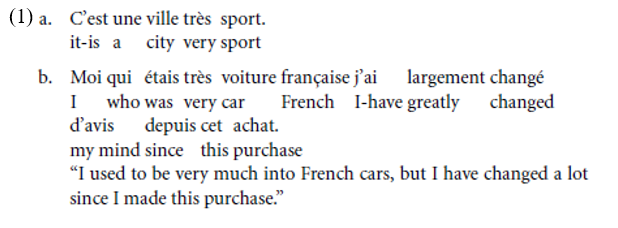
Even though similar structures are excluded in English and Dutch (∗too French car), it has to be noted that this type of predicative use of nouns is also excluded in these languages. A possible way to look at this is to assume that French has a conversion rule creating adjectives from nouns, as in (2):

The derivation in (2c) might seem at first sight implausible, but a morphological rule that operates on the basis of a phrase is not excluded, as the Dutch examples in (3) show.
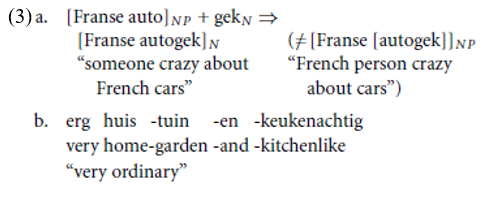
A further difference between très and the English and Dutch type A expressions is that très may modify passive participles, as opposed to past participles of active verbs (Creissels 2000; Carlier 2002):1
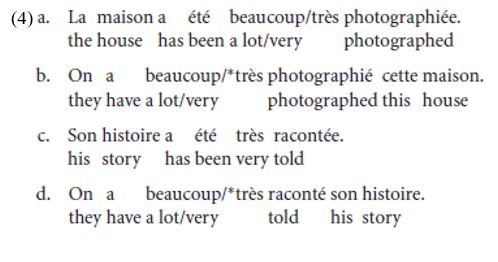
According to Creissels (2000), the passive sentences are homonymous with resultative sentences, in which the passive participle is reanalyzed as an adjective, which explains the use of très, which he considers to be a diagnostic for adjectivehood. In order to further motivate this claim, he shows that passive participles are compatible with modifiers such as depuis trois jours ‘since three days,’ modifiers that cannot be used in the corresponding active sentence:

Note that the use of a temporal modifier introduced by depuis is not limited to stative sentences. Clear passives can also accept this type of modifier, as illustrated in (6).

According to Carlier (2002) the past participle is still completely verbal and a true passive participle. She argues that the impersonal il-construction is incompatible with adjectives, but can be formed on the basis of passives with a“resultative” interpretation (Creissel’s adjectival resultatives). The sentence in (7a) has clearly such an interpretation, and indeed this sentence can give rise to an impersonal construction as in (7b). This is excluded for real adjectives, as shown in the pair in (7c, d).
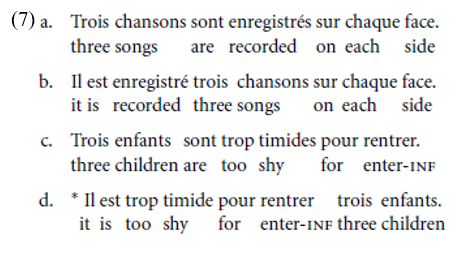
Note however that the use of très is never possible in the impersonal cases. Consider, for instance, the pair in (8):

If it is true that the impersonal construction can distinguish verbs from adjectives, the impossibility of très in (8) is a reason to believe that whenever the past participle combines with très it has to be analyzed as an adjective. I will leave this issue for further research. At this point the use of très in combination with a passive participle is not a reason to distinguish it from type A expressions in English and Dutch, given that passive participles might be analyzed as adjectival expressions.
However, there are two contexts where très is used and where type A expressions are prohibited. Contrary to the cases discussed above, we are clearly not dealing with independent differences between French on the one hand and Dutch and English on the other. As shown in (4) above, only passive participles have been claimed to have adjectival properties in French. Active past participles of eventive verbs do not allow modification by très. However, when we consider gradable verbs, we may observe that both the passive participle and the past participle of the active form may be modified by très, as well as the infinitive. Note that the use of très in the examples in (9b, c) is colloquial and will not be accepted by all speakers. What is important here is that there is a strong contrast between the use of très in (9b, c), and (9b, d) above.
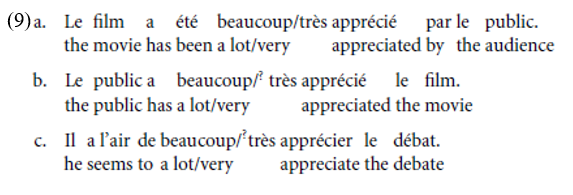
Even though the modification of gradable verbs is limited, the data seem to suggest that très might well be in the process of changing into a type B expression. Sentences such as the one in (9b) are clearly less common than the one in (9a), but they can be found easily on the internet: a très apprécié yields about 400 Google hits (Sept. 2006). Infinitives are slightly harder to find – très apprécier turns out to contain most often a misspelled participle – but they do occur as well, and according to a native speaker I consulted the example in (9c) sounds even slightly better than the one in (9b).2
An additional type B context that allows for the use of très is illustrated in (10). Très may be used in a restricted number of light verb constructions with a bare nominal predicate.3 Note that there are lexical restrictions on this use, as (10c) is excluded. This use of très is quite common, even though the dictionary Le Trésor de la Langue Française labels it as “improper.”
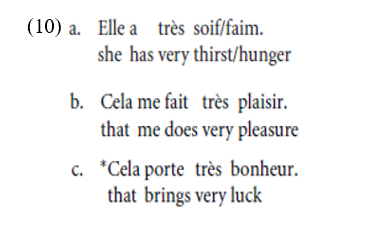
To conclude, the data in (9) and (10) are evidence in favor of the claim that French très is developing in the direction of a type B expression, which accounts for the clear non-adjectival contexts in which the modifier is used. As the context in (10) is much more common than the use of très with active past participles and infinitives of gradable verbs, the data suggest that these two contexts are ordered with respect to each other, the predicative nouns in (10) being closer to adjectives than the gradable verbs.
1There is a slight meaning difference between beaucoup and très in the (a) cases, which can be illustrated on the basis of the pair in (i). Ce journal ‘this journal’ in (ia) is not easily interpreted as a token, and refers to, for instance, Le Monde rather than to a crumpled newspaper laying on the table. Somehow, the use of très suggests that we are dealing with an intrinsic characteristic of the newspaper. I leave this issue for further research.
2 I have not found any cases where très follows the verb, and liaison (pronunciation of the final /z/ of très in front of a vowel) seems to be obligatory. These latter properties may reflect the properties of très in its more usual contexts.
3 Those who reject the adjectival analysis of sport and voiture française in (2) may want to assume that these cases are similar to the ones in (10), and involve modification of a gradable nominal predicate.